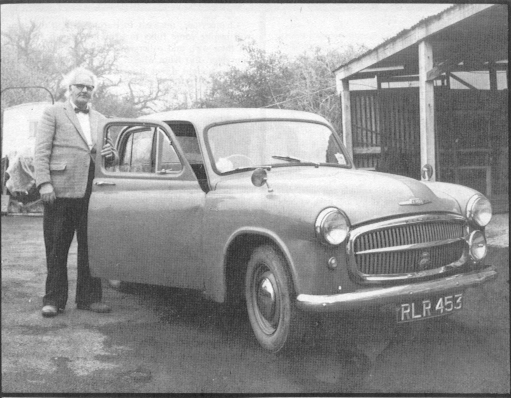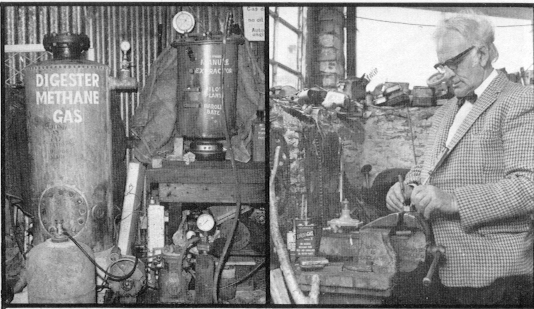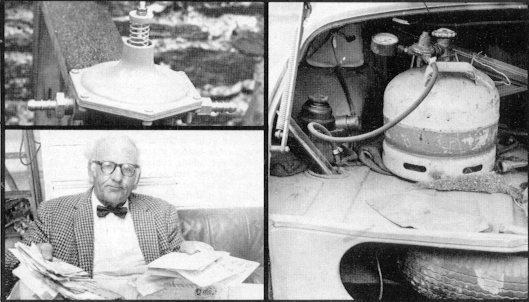
|
Simple, all
great ideas are. Harold Bate's pilot Manure Extractor and the Manure Digester that he uses for day-to-day generation of automobile and truck fuel. Note the high-pressure compressor with which Bate fills a storage bottle (lower left of photo) to pressure of 1100 pounds per square inch. "It all started with the Suez Crisis in 1953," Harold said. "When Egypt closed the canal, it blocked England's supply route with the Middle and Far East. This meant that petrol imports were crippled and fuel here in Great Britain was rationed. I got fed up with that and started looking round for an alternative form of power. I knew that gas engines were used before petrol (gasoline) and I also knew that gas was more efficient than petrol... so I began to experiment. "During the war I had done quite a bit of pig farming, and I knew that manure contained gases and that pig manure was very potent. A number of experimenters and sanitation facilities have been extracting gas from sewage for years now, but it's diluted so much that the process is slow. I therefore decided to concentrate on animal manure and find the best blend from which to extract methane... and then develop a method of feeding this gas into a car's engine. "After experiments with just about every type of animal manure, I found I got the best results from mixing that of chickens and pigs. Chicken manure contains more nitrogen than others and pig droppings are useful because they generate heat so well." Bate has also found a certain amount of straw and/or vegetable waste to be a valuable addition to his methane raw materials. The manure contributes mainly nitrogen and the straw provides carbon, it seems. The ideal mixture is about 75% droppings (half pig and half chicken) and 25% straw. Methane brewed up from this formula has a caloric value per liquid pound of 22,000 B.T.U. as compared to gasoline's 19,000, propane's 19,944 and butane's l9,680. The excreta-straw formula is first stacked up into a compost pile, doused with water and left exposed to the air for about a week of aerobic prefermentation. When this prefermentation is complete, about three hundred pounds of the mixture is shoveled into a heavy steel container (Bate recommends a trash- mongered domestic water heater) and sealed shut. A wait of four, five or even seven days-depending on conditions-is then necessary before fermentation of the first batch starts. If a little of the original mix is left behind as a starter, however, gas production will usually begin within 24 hours for all following batches. The real secret of a rapid, strong and complete transformation of waste into the maximum amount of methane is the maintenance of the 85 to 90ßF temperature at which the necessary bacteriological digestion is most active. If the temperature of the digester rises above 104ß F, no gas will be produced at all and -- in extremely hot regions -- a methane production unit should be shaded or otherwise protected from the heat. A digester set up in a temperate or cooler zone, on the other hand, may need some supplemental heating from an electric element inside the tank or a small kerosene (or methane!) flame under the unit. By the way, for those who speculate that the methane used to heat the digester might total more than the gas produced by the unit... not so! An extremely low flame (a car sump heater is ideal) under a Bate digester can cause the tank to yield a right vigorous flow of gas. Bate has fitted his digester tank with a safety valve set for 60 p.s.i. "just in case". Pressures in the ex-tractor seldom reach a third that level, however, because Harold considers a digester internal pressure of 20 p.s.i. to be the signal to start up a high-pressure compressor (of the type used for filling aqualung diving bottles) and pump the collected gas from the extractor into an ordinary high-pressure bottle. A filter between the digester and pressure bottle extracts the small quantities of phosphoric acid and ammonia that are present and the remaining almost pure methane liquefies at a pressure of 1110 p.s.i. Bate finds that it takes about one-half hour of steady pumping to fill a 32-pound (4.5 Imperial gallon) bottle to its capacity of liquid methane. This figures out to approximately 200 cubic feet of dry gas... or a fuel equivalent of seven gallons of good petrol (about eight and three-quarters gallon of high-test gasoline, to readers in the US). The digester will continue to produce for several weeks and will then have to be topped up with more manure and the sludge run off. All in all, a single filling of 300 pounds of manure will produce about 1500 cubic feet of methane equivalent to roughly 50 gallons of petrol (62 US gallons). That's not bad and Bate figures it costs trim only three cents to produce the equal of an Imperial gallon of petrol. Once he had a guaranteed supply of methane, Harold next faced the problem of getting the high-pressure gas into his car's engine in the exact amount required by the powerplant under all operating conditions. His answer, of course, was the now-famous 6" x 5" carburetor attachment which he calls the Bate Auto Gas Converter. The attachment (it looks like a model flying saucer) fits between the methane pressure bottle and the car's carburetor and allows the cylinders of the engine to suck just enough methane - and no more - from the bottle as the fuel is needed. The only modification made on the engine itself is the simple tubular jet which is threaded into the choke tube of the carburetor before the throttle butterfly valve. A run of rubber tubing connects this to the Bate converter and a further run goes back to wherever the methane bottle is carried. No mechanical linkage or other complicated modification is necessary. Incidentally,
the storage of the methane need not be restricted to high pressure
bottles. A rubber dinghy, air bed or even giant inner tubes carried
on the roof of the car would be just as effective... or as Bate says,
"Fill your tires with methane and run till they're flat!" Motoring
on methane offers more than the $.03-a-gallon economy mentioned earlier.
bate3 pic here) The gas gives 97 to 98% combustion compared to the 27% combustion (with the rest going out the exhaust in the form of carbon and pollution) of gasoline. So there's a definite ecological benefit. Engine wear is also markedly cut since methane, being dry, cannot dilute nor contaminate motor oil in the way that gasoline does... and spark plugs last much longer. "I've taken plugs out of my car after five years and more, and they've been as clean as the day I put them in," says Bate. "My car runs cleaner, smoother and has more power on methane." A demonstration drive in his famous 1953 chicken-powered Hillman: When he started the car on petrol and the vehicle broke into a rather lumpy idle, Bate flicked a switch on the dashboard and turned a knob on the steering column. "I've cut off the petrol," he explained. "When the float chamber on the carburetor empties, we'll be running on methane. You'll see the difference." In a matter of moments the rather weary 18-year-old engine settled down to a smooth purr and, on a short demonstration run, the bulky vehicle made light work of the switchback lanes around Bate's home. Throttle response was incredibly good and there were no fiat spots such as are common with carburetion using normal fuel in machines of this age. "I get five more miles to the gallon on methane than I get from an equivalent amount of petrol," Harold said. "This is because the dry methane has a higher calorific value and there is no waste of unvaporized fluid. Absence of oil dilution and reduced carbon deposits are just bonuses." Incidentally, all the advantages which methane bestows on an automobile-economy, pollution reduction, longer life and reduced maintenance-are just as evident when the gas is burned in tractors, trucks and stationary engines. Methane produced on the homestead can also be used to heat water, run a refrigerator, cook food, warm a house and do all the other jobs that we now do with natural gas. With a large enough digester and a ready supply of animal droppings, then, it is possible that a family farm might supply all its own power requirements from this one source alone. It certainly is possible to construct a methane generator large enough to power a homestead, and Mr. Bate has devised one that utilizes septic tank wastes. This large digester consists of a pit dug in the ground and lined with brick or concrete (a tank built on a low foundation above ground would also suffice) measuring approximately 10-feet square with an adjoining storage tank of the same size or larger. To prepare the system for non-stop production of methane, the usual septic tank vent pipe is fitted with a gas trap and any other openings are sealed. A no-return flap valve is fixed on the sewer pipe where it enters the digester (to keep the gas from escaping through the inlet) and another no-return valve is inserted in the line between the extractor and storage tank. This allows methane to pass to storage (but not return) as the gas is generated. A hole is then made in the digester cover and a thermostatic electric immersion heater is mounted so that it reaches well down into the raw sewage. The thermostat is set to give a steady heat of 85 to 90 degrees Fahrenheit and another small hole is drilled in the digester cover for the insertion of a check thermometer into the sewage from time to time. This last hole is fitted with a gas-tight stopper except for the brief periods when a temperature check is being made. If the tank is built above the ground, the digester can be heated by a steam pipe run through the contents and connected to the domestic hot water supply. It can also be heated by a gas ring or burner under the extractor and, once methane is being produced, this burner may be connected into the gas storage tank... allowing the system to heat itself. As ingenious as this arrangement may be, Harold Bate's restless mind is already far down the road to greater things. At the moment he's waiting for a patent on his discovery of a method for abstracting the liquid content from chicken manure. It seems that chicken droppings in their natural state are too sticky to be a convenient fertilizer... but - with the liquid abstracted - the manure makes two very good fertilizers, one dry and one liquid. "The so-called experts have been working on that one for years," chuckles Bate. "I solved it in no time. It's a question, I think, of overlooking the obvious. My next project, if and when I get the time, is the development of an electric car that will generate its own power. I know I can do it." In the meantime, Harold is still faced with the problem of convincing the boffins and powers-that-be to accept his already-proven ideas on methane. The Bate conversion, you see, has already received the stamp of official approval from the British Government's Ministry of Transport... but it seems distinctly unlikely that those chaps-who collect a 75% tax from the price of petrol-are going to advocate a mass changeover to homemade fuel at $.03 a gallon. The story is much the same right down the line: it takes money to promote and market do-it-yourself methane on a large scale... and the people with money generally find it to their advantage not to promote methane. Be that as it may, the facts speak for themselves. Bate's invention is simple, it's incredibly inexpensive... and it works. Hundreds of people, who are now driving chicken-powered cars the world over after contacting Mr. Bate directly, can vouch for that. And the word is beginning to spread. So-until a large firm finally sees the light, buys Harold out and begins to promote his digester and converter in a big way - Mr. Bate and his wife, Evelyn, will continue doing the job alone. And that means that, for as many as 18 hours a day, Evelyn will sit in the picturesque 16th-Century cottage answering letters while Harold handcrafts methane generators in a small workshop at the bottom of the garden path. That seems as nice a way to change the world as any. . |



